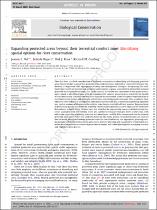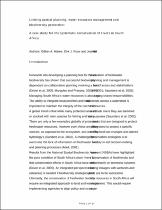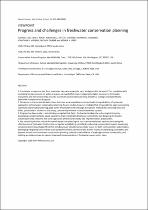 ResearchSpace
ResearchSpace
Expanding protected areas beyond their terrestrial comfort zone: identifying spatial options for river conservation
JavaScript is disabled for your browser. Some features of this site may not work without it.
- ResearchSpace
- →
- Research Publications/Outputs
- →
- Journal Articles
- →
- View Item
| dc.contributor.author |
Nel, JL

|
|
| dc.contributor.author |
Reyers, B

|
|
| dc.contributor.author |
Roux, DJ

|
|
| dc.contributor.author |
Cowling, RM

|
|
| dc.date.accessioned | 2009-10-27T10:15:16Z | |
| dc.date.available | 2009-10-27T10:15:16Z | |
| dc.date.issued | 2009-08 | |
| dc.identifier.citation | Nel, JL, Reyers, B, Roux, DJ and Cowling, RM. 2009. Expanding protected areas beyond their terrestrial comfort zone: identifying spatial options for river conservation. Biological Conservation, Vol. 142(8), pp 1605-1616 | en |
| dc.identifier.issn | 0006-3207 | |
| dc.identifier.uri | http://hdl.handle.net/10204/3701 | |
| dc.description | Copyright: 2009 Elsevier. This is the post print version of the work. It is posted here by permission of Elsevier for your personal use. Not for redistribution. The definitive version was published in the journal, Biological Conservation, Vol. 142(8), pp 1605-1616 | en |
| dc.description.abstract | There has been very little consideration of freshwater ecosystems in identifying and designing protected areas. Recent studies suggest that protected areas hold enormous potential to conserve freshwater biodiversity if augmented with appropriate planning and management strategies. Recognizing this need, South Africa’s relevant government authority commissioned a spatial assessment to inform their national protected area expansion strategy. This study presents the freshwater component of the spatial assessment, aimed at identifying focus areas for expanding the national protected area system for the benefit of river biodiversity. Conservation objectives to guide the assessment aimed to improve representation of river biodiversity pattern and processes in both new and existing protected areas. Data to address these objectives were collated in a Geographic Information System (GIS) and a conservation planning algorithm was used as a means of integrating the multiple objectives in a spatially efficient manner. Representation of biodiversity pattern was based on achieving conservation targets for 222 river types and 47 freshwater fish endemic to South Africa. Options were also identified for representing coarse-scale biodiversity processes associated with free-flowing rivers and catchment-estuarine linkages. River reaches that, with only minor expansion of existing protected area boundaries, could be fully incorporated into the national protected area system were also identified. Based on this study, generic recommendations are made on how to locate, design and manage protected areas for river biodiversity, use appropriate planning units, incorporate both biodiversity pattern and process, improve planning and management of individual protected areas, incorporate a mixture of protection strategies, and embed planning into an ongoing research and implementation process. | en |
| dc.language.iso | en | en |
| dc.publisher | Elsevier | en |
| dc.subject | Systematic conservation planning | en |
| dc.subject | River conservation | en |
| dc.subject | Gap analysis | en |
| dc.subject | Conservation assessment | en |
| dc.subject | Conservation planning | en |
| dc.subject | Free-flowing rivers | en |
| dc.subject | Coast catchment | en |
| dc.subject | Estuary | en |
| dc.subject | Biological conservation | en |
| dc.subject | Freshwater ecosystems | en |
| dc.subject | Freshwater biodiversity | en |
| dc.subject | River biodiversity | en |
| dc.subject | River | en |
| dc.title | Expanding protected areas beyond their terrestrial comfort zone: identifying spatial options for river conservation | en |
| dc.type | Article | en |
| dc.identifier.apacitation | Nel, J., Reyers, B., Roux, D., & Cowling, R. (2009). Expanding protected areas beyond their terrestrial comfort zone: identifying spatial options for river conservation. http://hdl.handle.net/10204/3701 | en_ZA |
| dc.identifier.chicagocitation | Nel, JL, B Reyers, DJ Roux, and RM Cowling "Expanding protected areas beyond their terrestrial comfort zone: identifying spatial options for river conservation." (2009) http://hdl.handle.net/10204/3701 | en_ZA |
| dc.identifier.vancouvercitation | Nel J, Reyers B, Roux D, Cowling R. Expanding protected areas beyond their terrestrial comfort zone: identifying spatial options for river conservation. 2009; http://hdl.handle.net/10204/3701. | en_ZA |
| dc.identifier.ris | TY - Article AU - Nel, JL AU - Reyers, B AU - Roux, DJ AU - Cowling, RM AB - There has been very little consideration of freshwater ecosystems in identifying and designing protected areas. Recent studies suggest that protected areas hold enormous potential to conserve freshwater biodiversity if augmented with appropriate planning and management strategies. Recognizing this need, South Africa’s relevant government authority commissioned a spatial assessment to inform their national protected area expansion strategy. This study presents the freshwater component of the spatial assessment, aimed at identifying focus areas for expanding the national protected area system for the benefit of river biodiversity. Conservation objectives to guide the assessment aimed to improve representation of river biodiversity pattern and processes in both new and existing protected areas. Data to address these objectives were collated in a Geographic Information System (GIS) and a conservation planning algorithm was used as a means of integrating the multiple objectives in a spatially efficient manner. Representation of biodiversity pattern was based on achieving conservation targets for 222 river types and 47 freshwater fish endemic to South Africa. Options were also identified for representing coarse-scale biodiversity processes associated with free-flowing rivers and catchment-estuarine linkages. River reaches that, with only minor expansion of existing protected area boundaries, could be fully incorporated into the national protected area system were also identified. Based on this study, generic recommendations are made on how to locate, design and manage protected areas for river biodiversity, use appropriate planning units, incorporate both biodiversity pattern and process, improve planning and management of individual protected areas, incorporate a mixture of protection strategies, and embed planning into an ongoing research and implementation process. DA - 2009-08 DB - ResearchSpace DP - CSIR KW - Systematic conservation planning KW - River conservation KW - Gap analysis KW - Conservation assessment KW - Conservation planning KW - Free-flowing rivers KW - Coast catchment KW - Estuary KW - Biological conservation KW - Freshwater ecosystems KW - Freshwater biodiversity KW - River biodiversity KW - River LK - https://researchspace.csir.co.za PY - 2009 SM - 0006-3207 T1 - Expanding protected areas beyond their terrestrial comfort zone: identifying spatial options for river conservation TI - Expanding protected areas beyond their terrestrial comfort zone: identifying spatial options for river conservation UR - http://hdl.handle.net/10204/3701 ER - | en_ZA |








